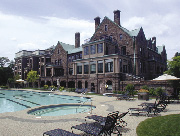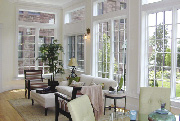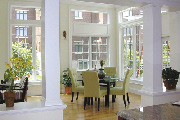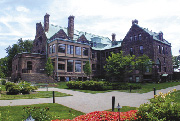Considered the crown jewel of historic Fisher Hill, Longyear Manor has been completely renovated and transformed by HDS Architecture into one of metro Boston's premier luxury condominium residences.
The 28,000 s/f mansion was originally constructed in 1890-92 on a lake view site in Marquette, Michigan by John and Mary Longyear, who made their fortune through the discovery of mineral deposits in the Great Lakes and Norway. In 1903 the mansion was moved to Brookline when the couple wished to live near the Mother Church of the First Church of Christ Scientist. The Richardsonian Romanesque façade was dismantled and transported more than 1,300 miles in 190 freight cars to its current hill-crest location. Upon Mary Longyear's death in 1931, the mansion became the Longyear Foundation, housing a museum and archive of early Christian Scientist documents and artifacts.
HDS has painstakingly redesigned the building to accommodate five exquisitely handcrafted, single story condominium units ranging in size from 2,300 s/f to 5,500 s/f. The first and second floors each house two condominiums, with a penthouse on the third floor, all with 12-14 foot ceilings, grand hallways, fireplaces, private terraces and multiple views of the manicured grounds. Already the project has attracted celebrity interest. Three of the five units have sold to buyers including a local sports star and noted business owners.
The greatest challenge that faced Hans Strauch, principal of HDS Architecture on this project, was how to retain the building's old world charm while providing today's ultra-modern comforts. The original single family residence was completely reconfigured in order to transform the building into a multi-family residence. In addition, the mansion had been left in disrepair for decades, suffering damage to the interior structural components as well as its exterior stone, windows and copper shingle roof.
Working closely with the Brookline preservation commission and the Brookline planning board, HDS sensitively designed additions and dormers that all look like part of the original mansion. New dormers create more livable space and light on the third floor, as do the sunroom additions with restored interior stone. A large skylight was repaired and new skylights created. The copper shingled roof, damaged by leaks and age, has been restored and enhanced. Asbestos has been removed. All 200-plus windows have been replaced, echoing the historic single glazed windows which were in disrepair. All the chimneys have been repaired, and the exterior stone has been cleaned and stabilized.
HDS has erected partitions to reconfigured rooms to accommodate new uses. The former living room is now an eat-in kitchen with a fireplace. The dining room has become a master bedroom suite, a music room is a grand living room, and the third floor theatre has become a living room with a bar.
The condominiums units have been designed to express the grandness of the estate. Finish materials include marble and hardwood floors, granite kitchen countertops, marble bathroom countertops, porcelain tile showers and raised panel cherry wood kitchen cabinets. The individual spaces within the units are generously proportioned with soaring ceilings finely detailed casework, satin nickel hardware and state-of-the-art electrical and security controls.
Each unit has been individually planned, creating a collection of unique, private and independent residences. The procession and sequence of space has been carefully considered echoing the dramatic interior experience of the original Longyear Manor. Typical interior spaces include a grand foyer entrance, living room, dining room, eat-in kitchen, family room, library, master bedroom suite with his and hers walk-in closets and bathrooms, guest bedroom suites and rooftop garden terraces.
A new elevator has been installed, running from the lower level fitness room and garage to each floor. A spacious and sun lit tunnel connects the underground garage to the building. The fitness club, with an adjacent magnificently restored outdoor heated pool, is easily accessible to all residents. The gated community has 24-hour security. Six of the eight acres will remain open space. Its manicured grounds and sweeping gardens have been landscaped with impeccable artistry with the grandeur of a European country estate with a formal entry plaza.
Fisher Hill, which is listed in the National Register of Historic Places, and the access to the Longyear Estate were designed by renowned landscape architect Frederick Law Olmstead, who also designed Boston's Emerald Necklace and New York City's Central Park. HDS Architecture is preserving Olmstead's original landscape design concept, with a long entrance drive past the gatehouse through a park to the mansion.
HDS was chosen by the developer of this project, Longyear Properties LLC, because of the firm's successful reputation with sensitive historic renovations. In addition to Longyear Manor, HDS recently adapted a historic waterfront mill building complex in Rhode Island into a loft condominium community.
Tags:
HDS Architecture restores 28,000 s/f Longyear Manor into 5-unit condo
September 18, 2008 - Construction Design & Engineering
 (1).jpg)











.png)